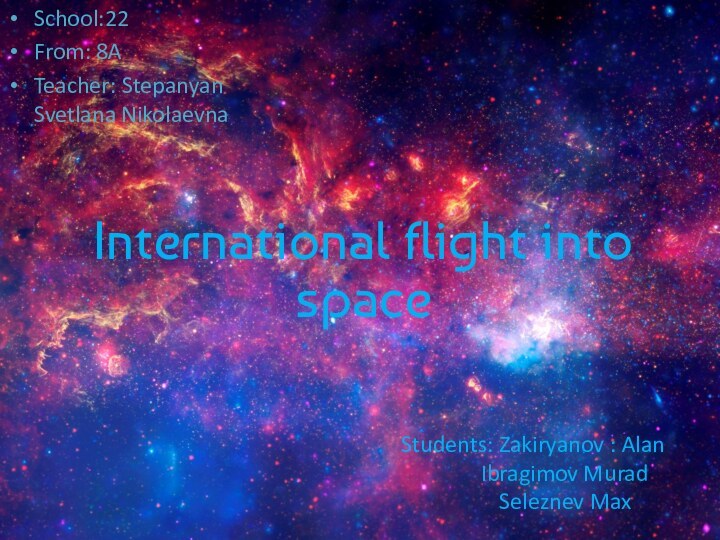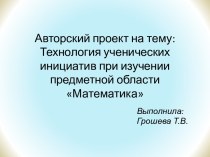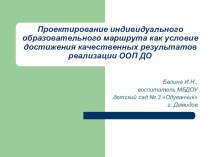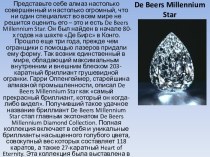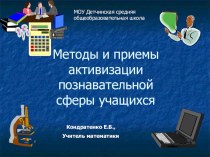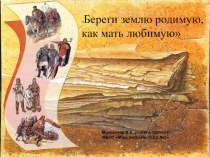Слайд 2
«The first flights into space»
Yuri Gagarin is often
compared with such important events that have become historic
landmarks like Christopher Columbus, which led to the discovery of America, or the first flight across the Atlantic, committed by Charles Lindbergh.
In the Soviet Union the successful implementation of the first manned space flight was also seen as a great triumph in the Cold War against the United States.
Launching a spacecraft "Vostok" April 12, 1961 confirmed the high technical and scientific level of the USSR and the accelerated development of the space program in the United States. The flight showed the possibility of a normal human stay in space. Yuri Gagarin became one of the most famous people in the world
Слайд 3
«The first flights into space»
Crew
The crew - Yuri
Gagarin
Backup crew - German Titov
Support Crew - Grigory Nelyubov
Design
East
(spacecraft)
unit weight - 4,725 tons;
The diameter of the sealed enclosure - 2.2 m;
Length (without antenna) - 4.4 m;
Maximum diameter - 2.43 m.
French President Charles de Gaulle, "the success of Soviet scientists and astronauts does honor Europe and humanity."
Слайд 4
«History of theory astronautic»
The idea of space travel
came after the appearance of the heliocentric system of
the world, when it became clear that the world - is an object, like the Earth, and thus, in principle, people could visit them. The first published description of human presence on the Moon was the fantastic story of Kepler «Somnium» (written 1609, published 1634).
The early history of astronautics is theoretical: the fundamental mathematics of space travel was established by Isaac Newton in his 1687 treatise Philosophiae Naturalis Principia Mathematica.
Слайд 5
«Space tourism»
Space tourism is space travel for recreational,
leisure or business purposes. A number of startup companies
have sprung up in recent years, such as Virgin Galactic and XCOR Aerospace, hoping to create a sub-orbital space tourism industry. Orbital space tourism opportunities have been limited and expensive, with only the Russian Space Agency providing transport to date.
The publicized price for flights brokered by Space Adventures to the International Space Station aboard a Russian Soyuz spacecraft have been US $20–40 million, during the period 2001–2009 when 7 space tourists made 8 space flights. Some space tourists have signed contracts with third parties to conduct certain research activities while in orbit.
Слайд 6
Russia halted orbital space tourism in 2010 due
to the increase in the International Space Station crew
size, using the seats for expedition crews that would have been sold to paying spaceflight participants. Orbital tourist flights are planned to resume in 2015.
As an alternative term to "tourism", some organizations such as the Commercial Spaceflight Federation use the term "personal spaceflight". The Citizens in Space project uses the term "citizen space exploration".
As of September 2012, multiple companies are offering sales of orbital and suborbital flights, with varying durations and creature comforts.
Слайд 7
«Orbital space tourism»
At the end of the 1990s,
MirCorp, a private venture that was by then in
charge of the space station, began seeking potential space tourists to visit Mir in order to offset some of its maintenance costs. Dennis Tito, an American businessman and former JPL scientist, became their first candidate. When the decision to de-orbit Mir was made, Tito managed to switch his trip to the International Space Station (ISS) through a deal between MirCorp and U.S.-based Space Adventures, Ltd., despite strong opposition from senior figures at NASA; from the beginning of the ISS expeditions, NASA stated it wasn't interested in space guests. Nonetheless, Dennis Tito visited the ISS on April 28, 2001, and stayed for seven days, becoming the first "fee-paying" space tourist. He was followed in 2002 by South African computer millionaire Mark Shuttleworth.
Слайд 8
The third was Gregory Olsen in 2005, who

was trained as a scientist and whose company produced
specialist high-sensitivity cameras. Olsen planned to use his time on the ISS to conduct a number of experiments, in part to test his company's products. Olsen had planned an earlier flight, but had to cancel for health reasons. The Subcommittee on Space and Aeronautics Committee On Science of the House of Representatives held on June 26, 2001 reveals the shifting attitude of NASA towards paying space tourists wanting to travel to the ISS. The hearing's purpose was to, "Review the issues and opportunities for flying nonprofessional astronauts in space, the appropriate government role for supporting the nascent space tourism industry, use of the Shuttle and Space Station for Tourism, safety and training criteria for space tourists, and the potential commercial market for space tourism". The subcommittee report was interested in evaluating Dennis Tito's extensive training and his experience in space as a nonprofessional astronaut.
Слайд 9
By 2007, space tourism was thought to be
one of the earliest markets that would emerge for
commercial spaceflight.:11 However, as of 2014 this private exchange market has not emerged to any significant extent.
Space Adventures remains the only company to have sent paying passengers to space. In conjunction with the Federal Space Agency of the Russian Federation and Rocket and Space Corporation Energia, Space Adventures facilitated the flights for all of the world's first private space explorers. The first three participants paid in excess of $20 million (USD) each for their 10-day visit to the ISS.
Слайд 10
After the Columbia disaster, space tourism on the
Russian Soyuz program was temporarily put on hold, because
Soyuz vehicles became the only available transport to the ISS. On July 26, 2005, Space Shuttle Discovery (mission STS-114) marked the shuttle's return to space. Consequently, in 2006, space tourism was resumed. On September 18, 2006, an Iranian American named Anousheh Ansari became the fourth space tourist (Soyuz TMA-9).) On April 7, 2007, Charles Simonyi, an American businessman of Hungarian descent, joined their ranks (Soyuz TMA-10). Simonyi became the first repeat space tourist, paying again to fly on Soyuz TMA-14 in March–April 2009. Canadian Guy Laliberté became the next space tourist in September, 2009 aboard Soyuz TMA-16.
Слайд 11
As reported by Reuters on March 3, 2010,

Russia announced that the country would double the number
of launches of three-man Soyuz ships to four that year, because "permanent crews of professional astronauts aboard the expanded station are set to rise to six"; regarding space tourism, the head of the Russian Cosmonauts' Training Center said "for some time there will be a break in these journeys".
On January 12, 2011, Space Adventures and the Russian Federal Space Agency announced that orbital space tourism would resume in 2013 with the increase of manned Soyuz launches to the ISS from four to five per year. However, this has not materialized, and the current preferred option, instead of producing an additional Soyuz, would be to extend the duration of an ISS Expedition to one year, paving the way for the flight of new spaceflight participants. The British singer Sarah Brightman initiated plans (costing a reported $52 million) and participated in preliminary training in early 2015, expecting to then fly (and to perform while in orbit) in September 2015, but in May 2015 she postponed the plans indefinitely.
Слайд 12
«Perspective of space tourism»
The most important disadvantage of
this type of tourist destination of the original can
be considered a large size pleasure payment. According to various reports, the cost of flying in space can range now between 20 and 40 million dollars. As additional entertainment kosmoturichticheskimi companies offer a new service - the output of cosmo-tourists into space, the price of such extremes is about 15 million dollars.
SpaceShipTwo - suborbital space ship
Also, except for additional services, which are developed by modern companies, plans to build a space of housing for travelers. In that "unearthly" hotel experience will be even more exotic than when making the flight. The main features of space at the same hotel will be considered:
The presence of "ground" of the spectrum of hotel services under special conditions.
Слайд 13
The original view from the window.
The possibility of
living in a state of weightlessness.
The most relevant at
this point is "Bigelow Aerospace" project of the company, which was founded in 1999. After extensive research NASA space project and the subsequent purchase of the patent owner of the company, in June 2006, Russia launched the Genesis-1 - an experimental satellite "Bigelow Aerospace", which was created by the new technologies. And in 2007, on the launch vehicle "Dnepr" launched the Genesis-2. The basic meaning of action is made to create opportunities for the transfer of a residential unit with an inflatable envelope in the open space.
Tourist hotel in space
By 2012 it is planned to build space hotels two developers - companies «Galactic Suite» and «Bigelow Aerospace».
